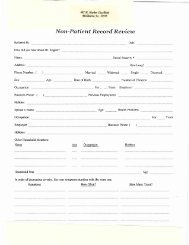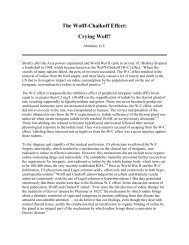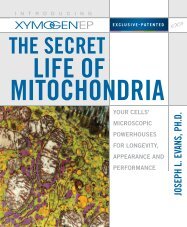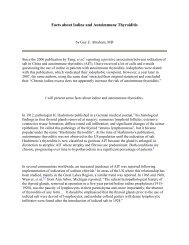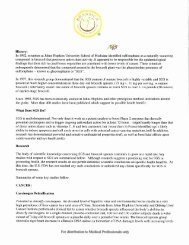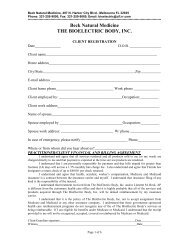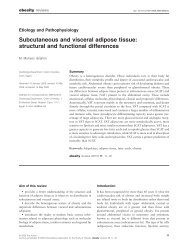The bioavailability of iodine applied to the skin - Beck Natural ...
The bioavailability of iodine applied to the skin - Beck Natural ...
The bioavailability of iodine applied to the skin - Beck Natural ...
Create successful ePaper yourself
Turn your PDF publications into a flip-book with our unique Google optimized e-Paper software.
<strong>The</strong> two questions mentioned previously can now be answered:<br />
I. Is <strong>the</strong> cutaneous route <strong>of</strong> <strong>iodine</strong> supplementation practical and effective?<br />
II. Does <strong>the</strong> <strong>skin</strong> <strong>iodine</strong> patch test give a reliable indication <strong>of</strong> whole body sufficiency for<br />
<strong>iodine</strong>?<br />
To answer <strong>the</strong> first question, we will use <strong>the</strong> data in <strong>the</strong> six subjects who were exposed <strong>to</strong> 160 mg<br />
<strong>iodine</strong> via cutaneous application, because <strong>the</strong> mean serum iodide levels were relatively constant over<br />
<strong>the</strong> 24 hr period: 0.27 mg/L at 2 hr; 0.2 mg/L at 6 hr and 0.24 mg/L at 24 hr post intervention. <strong>The</strong><br />
mean value <strong>of</strong> <strong>the</strong> 3 means is 0.24 mg/L iodide. <strong>The</strong> average amount <strong>of</strong> <strong>iodine</strong> bioavailable in <strong>the</strong>se<br />
6 subjects would be <strong>the</strong> product <strong>of</strong> <strong>the</strong> serum iodide levels by <strong>the</strong> renal clearance <strong>of</strong> iodide, that is<br />
43.5 L/day (3) . 0.24 mg iodide/L × 43.5 L/day = 10.4 mg. <strong>The</strong> percent <strong>of</strong> bioavailable <strong>iodine</strong> from<br />
160 mg <strong>applied</strong> <strong>to</strong> <strong>the</strong> <strong>skin</strong> is 10.4 x 100 / 160 = 6.5%. If <strong>the</strong> data reported by Nyiri and Jannitti 1 in<br />
dogs can be extrapolated <strong>to</strong> humans, that is 12% <strong>of</strong> <strong>the</strong> <strong>applied</strong> <strong>iodine</strong> was available for utilization by<br />
<strong>the</strong> body, with 88% evaporated; <strong>the</strong>n some 50% <strong>of</strong> <strong>the</strong> remaining <strong>skin</strong> depot <strong>of</strong> <strong>iodine</strong> was available<br />
during <strong>the</strong> first 24 hrs following <strong>skin</strong> exposure <strong>to</strong> <strong>iodine</strong>. One can conclude that <strong>skin</strong> application <strong>of</strong><br />
<strong>iodine</strong> is an effective if not efficient and practical way for supplementation <strong>of</strong> <strong>iodine</strong> with an<br />
expected <strong>bioavailability</strong> <strong>of</strong> 6 <strong>to</strong> 12% <strong>of</strong> <strong>the</strong> <strong>to</strong>tal <strong>iodine</strong> <strong>applied</strong> <strong>to</strong> <strong>the</strong> <strong>skin</strong>. <strong>The</strong> serum iodide levels<br />
were 10 times higher 2 hr post intervention with oral ingestion <strong>of</strong> 100 mg iodide than with 160 mg<br />
<strong>iodine</strong> <strong>applied</strong> <strong>to</strong> <strong>the</strong> <strong>skin</strong> (Fig. 2) .



